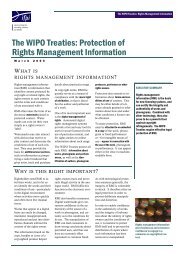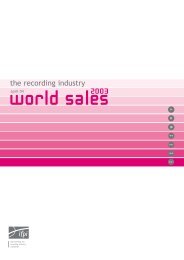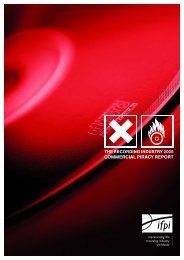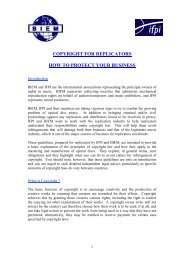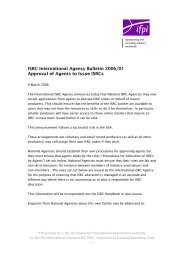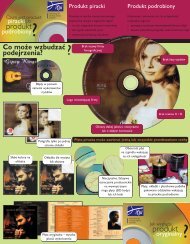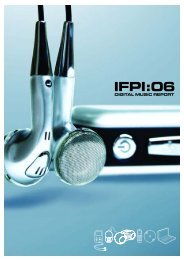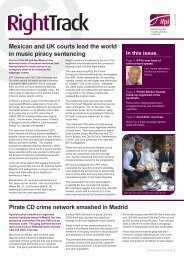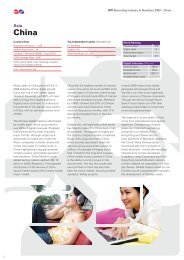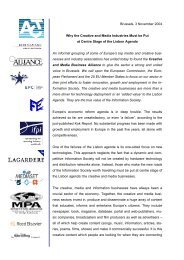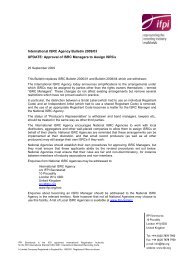The WIPO Treaties: Technological Measures - IFPI
The WIPO Treaties: Technological Measures - IFPI
The WIPO Treaties: Technological Measures - IFPI
You also want an ePaper? Increase the reach of your titles
YUMPU automatically turns print PDFs into web optimized ePapers that Google loves.
<strong>WIPO</strong> <strong>Treaties</strong>: <strong>Technological</strong> Protections<br />
Page 2<br />
H OW SHOULD THIS BE IMPLEMENTED?<br />
<strong>WIPO</strong> TREATY TEXT<br />
WCT Art. 11.<br />
Contracting Parties shall provide<br />
adequate legal protection and<br />
effective legal remedies against<br />
the circumvention of effective<br />
technological measures that are<br />
used by authors in connection<br />
with the exercise of their rights<br />
under this Treaty or the Berne<br />
Convention and that restrict acts,<br />
in respect of their works, which<br />
are not authorised by the authors<br />
concerned or permitted by law.<br />
WPPT Art. 18.<br />
Contracting Parties shall provide<br />
adequate legal protection and<br />
effective legal remedies against<br />
the circumvention of effective<br />
technological measures that are<br />
used by performers or producers<br />
of phonograms in connection<br />
with the exercise of their rights<br />
under this Treaty and that<br />
restrict acts, in respect of their<br />
performances or phonograms,<br />
which are not authorised by the<br />
performers or the producers of<br />
phonograms concerned or<br />
permitted by law.<br />
Most countries are finding that<br />
their copyright laws require<br />
some modernising to deal with<br />
TPM protection adequately.<br />
<strong>The</strong>re are several elements that<br />
governments and rights owners<br />
have found crucial to effective<br />
legal protection for TPMs:<br />
•Protection of access and copy<br />
control technologies. <strong>The</strong> treaties<br />
require protection of TPMs (1)<br />
that are used in connection with<br />
the exercise of rights, and (2)<br />
that restrict unauthorised acts.<br />
This only covers TPMs applied<br />
to works protected by copyright<br />
or related rights.<br />
Clearly this protection should<br />
apply to copy and use control<br />
TPMs that directly restrict unauthorised<br />
reproduction, public<br />
communication, or other direct<br />
exercises of the rights owner’s<br />
rights.<br />
Protection likewise should apply<br />
to access-control technologies,<br />
which also meet both tests<br />
of the treaties. Rights owners<br />
use access control, presently the<br />
most popular type of TPM, in<br />
connection with the exercise of<br />
their rights—whether selling<br />
physical copies or disseminating<br />
electronic copies to the public.<br />
Access controls not only prevent<br />
unauthorised use but also<br />
discourage unauthorised reproduction,<br />
distribution and transmission.<br />
• Protection against act of circumvention.<br />
<strong>The</strong> treaties explicitly<br />
require legal protection and effective<br />
remedies against the act<br />
of circumvention of TPMs.<br />
Circumvention is sometimes<br />
called ‘hacking’—manipulating<br />
the technological measure in<br />
some way so as to limit or<br />
eliminate the function it was<br />
designed to perform. <strong>The</strong> US<br />
law implementing the treaties<br />
defined circumvention as<br />
‘avoiding, bypassing, removing,<br />
deactivating, or otherwise impairing’<br />
a technological measure.<br />
• Prohibition of circumventing<br />
devices. Adequate legal protection<br />
and effective legal remedies<br />
cannot stop at prohibiting circumvention<br />
itself. In order to<br />
control widespread hacking and<br />
other circumventing activities,<br />
circumvention devices and<br />
other means designed to facilitate<br />
hacking also must be controlled.<br />
This does not require outlawing<br />
multi-purpose devices like personal<br />
computers as such, simply<br />
because they can be used for a<br />
range of illicit purposes. Governments<br />
have recognised that<br />
devices must be controlled,<br />
however, if they are designed or<br />
adapted to circumvent.<br />
This formulation has been refined<br />
in EU legislation and elsewhere<br />
to include devices that<br />
(1) are primarily designed or produced<br />
for the purpose of circumvention,<br />
(2) have only a limited<br />
commercially significant purpose or<br />
use other than to circumvent; or<br />
(3) are marketed, promoted or<br />
advertised for circumvention<br />
purposes.<br />
•Devices, components and other<br />
means. Circumvention devices<br />
are not always an isolated<br />
‘black box’, such as a pirate decoder.<br />
<strong>The</strong>y can also be one<br />
part of a more complex piece of<br />
equipment, or an intangible<br />
means such as computer software<br />
or access codes, that has<br />
the same function as a standalone<br />
circumvention device.<br />
It is thus important that rules on<br />
circumvention devices apply<br />
equally to parts and components<br />
of devices, software, algorithms<br />
and access information such as<br />
passwords and access codes that<br />
otherwise meet the definition of<br />
an illicit device.<br />
•Manufacture, distribution, offering<br />
to the public, communication of<br />
devices and services. A range of<br />
activities related to circumvention<br />
devices should be covered.<br />
In most cases, treaty implementing<br />
legislation has extended<br />
to all manner of manufacture,<br />
marketing, offering to<br />
the public and distribution of<br />
circumvention devices, as well<br />
as services that assist with such<br />
circumvention.<br />
Not only are the features of<br />
TPMs and devices subject to<br />
continuous change, but the<br />
catalogue of activities that promote<br />
circumvention of TPMs<br />
also will change over time—<br />
requiring a broad definition of<br />
the acts covered by legislation<br />
dealing with circumvention devices<br />
and services.<br />
• Effective remedies. <strong>The</strong> treaties<br />
also explicitly call for effective<br />
legal remedies. This is of<br />
great importance, because action<br />
against hacking and other<br />
circumvention of TPMs must<br />
be sufficiently speedy, efficient<br />
and deterrent to counteract the<br />
otherwise great incentive hackers<br />
and pirates have to break<br />
TPMs and steal content.<br />
Effective legal remedies should<br />
include both criminal law sanctions<br />
and civil law remedies.<br />
Criminal penalties should permit<br />
fines and prison terms in<br />
appropriate cases.<br />
To serve as a deterrent, civil law<br />
should allow fast and efficient<br />
preliminary proceedings, injunctive<br />
relief, payment of damages<br />
including statutory damages,<br />
and the obligation to cooperate<br />
in neutralising harm<br />
already caused.<br />
To get illicit devices out of circulation,<br />
remedies also should<br />
allow tracing, seizure, retention<br />
and destruction of physical devices<br />
and intangible software<br />
and information.<br />
Criminal penalties and civil<br />
remedies should not be any<br />
lower than those available for<br />
copyright infringement.




